Nakaya's favorites
■Introduction
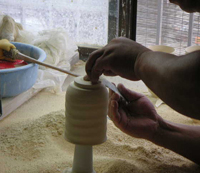 We, Nakaya love not only Imariyaki but pottery as a whole.
Porcelain or earthenware irrespective of country of origin are wonderful crafts. Some of the works really give pleasure to look at. Even though we have expressed bright color in Maki-e (base of most of Nakaya products) by adopting new materials, the special feature of lacquering is the difficulty in expressing bright colors.
As all our valuable customers are aware, we express whiteness of the lacquer by using the calla of the egg and the shellfish. Because the whiteness of lacquer is not the pure white. White material in Porcelain craft was discovered 600 years ago, giving an impact on the craft. "Beautiful white" and "Transparent blue" had enchanted people as an attribute of pottery.
We, Nakaya love not only Imariyaki but pottery as a whole.
Porcelain or earthenware irrespective of country of origin are wonderful crafts. Some of the works really give pleasure to look at. Even though we have expressed bright color in Maki-e (base of most of Nakaya products) by adopting new materials, the special feature of lacquering is the difficulty in expressing bright colors.
As all our valuable customers are aware, we express whiteness of the lacquer by using the calla of the egg and the shellfish. Because the whiteness of lacquer is not the pure white. White material in Porcelain craft was discovered 600 years ago, giving an impact on the craft. "Beautiful white" and "Transparent blue" had enchanted people as an attribute of pottery.
Besides working with Makie-e for our Fountain Pens, we also
plan to produce variesties of bright colored lacquer made
fountain pen accessories and porcelain as well.
■Ko-Imariyaki
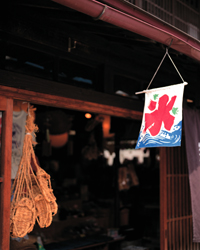 In the late 1500s, Hideyoshi Toyotomi was the
Shougun(political ruler of Japan) at that time and invaded Korea. When his armed forces withdrew from Korea, Naoshige Nabeshima who was the feudal lord of Saga clan brought the Korea potters in Kyusyu. This is a start of the technical introduction of the porcelain production in Japan.
Eight years later, white clay quarry was discovered at Izumiyama(Izumi mountain, Arita) in Hizen(Saga Prefecture, Kyusyu) and the porcelain was produced for the first time in Japan.
In the early 1600s, almost at the same time as the beginning of Edobakufu, the history of the pottery in Japan begun to change to the surprising white porcelain.
In Arita where is the birth place of Japanese porcelain, the porcelain of the high quality was produced as the special product of the Nabeshima clan. Because these porcelain were shipped to other Japanese cities and elsewhere in Asia and Europe from the Imari port, Aritayaki is thus called "Imariyaki" in foreign countries and the classical Imariyaki made until Edo period is also called "Ko-Imari" as " Old Imari".
In the late 1500s, Hideyoshi Toyotomi was the
Shougun(political ruler of Japan) at that time and invaded Korea. When his armed forces withdrew from Korea, Naoshige Nabeshima who was the feudal lord of Saga clan brought the Korea potters in Kyusyu. This is a start of the technical introduction of the porcelain production in Japan.
Eight years later, white clay quarry was discovered at Izumiyama(Izumi mountain, Arita) in Hizen(Saga Prefecture, Kyusyu) and the porcelain was produced for the first time in Japan.
In the early 1600s, almost at the same time as the beginning of Edobakufu, the history of the pottery in Japan begun to change to the surprising white porcelain.
In Arita where is the birth place of Japanese porcelain, the porcelain of the high quality was produced as the special product of the Nabeshima clan. Because these porcelain were shipped to other Japanese cities and elsewhere in Asia and Europe from the Imari port, Aritayaki is thus called "Imariyaki" in foreign countries and the classical Imariyaki made until Edo period is also called "Ko-Imari" as " Old Imari".
■What is Imariyaki?
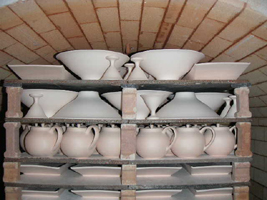 Imariyaki(Aritayaki) is roughly divided into
three styles of the Koimariyaki style, the Kakiemon style and the Nabeshima style. These characteristic are as follows.
Imariyaki(Aritayaki) is roughly divided into
three styles of the Koimariyaki style, the Kakiemon style and the Nabeshima style. These characteristic are as follows.
●Ko-Imariyaki
As for the characteristic of Ko-Imari, the colors such as gold and red etc, are used in abundance and it is often expressed that they are gorgeous, brilliant and free, generous as shown in the doll and the vessel etc. It is thought that this was because of producing them according to the foreigner's order. Among them, there is some Ko-Imari produced by only indigo color.
●Kakiemon
In 1645, since Sakaida Kakiemon produced Akae for the first time,
the Arita porcelain got the fame further. It is said that this is
iroe porcelain(polychrome ware) for the first time in Japan.
The first characteristic of Kakiemon is the milk-white foundation
called "Nigoshite".The second one is the "Saiyu" used for the uwae.
Many kinds of colors is used such as red, green, gold, yellow, blue,
purple and black etc. and sometimes silver. Especially, they had much
difficulty in producing various red colors. And these red are recognized
all over the world. Moreover, as it is said that the characteristic of
Kakieon is the iroe to accentuate the white of the hakuji, they has a
lot of space and are the clear and neat style. Also, as to the Kakiemon,
the red of the persimmon color is too famous. However, Higashijima
Tokuzaemon in Imari learned the method of the iroezuke from Chinese
who came to Nagasaki and told this to Kakiemon. Then, in 1643, he
succeeded in the iroezuke with great pains.
●Nabeshima
In Nabeshima, there are Iro-Nabeshima and Nabeshima Seiji/
Sometsuke(celadon with blue-and white decoration).
Especialy, the characteristic of Iro-Nabeshima is to be limited
to three colors(red, yellow, green) and the lines drawn are very thin
and don't have the useless play.
■List of works
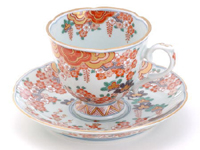
|
|
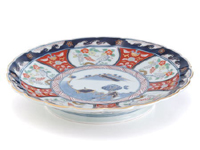
|
|
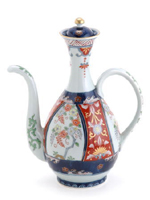
|
|
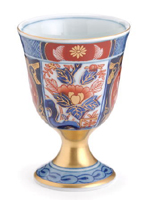
|
| Coffee cup plate set |
|
Plate |
|
Jug |
|
Wineglass |
|
|
|
|
|
|
|
|
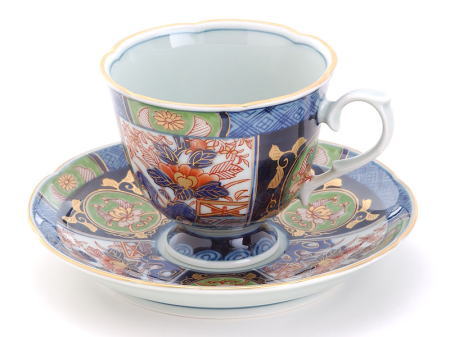
作品名:古伊万里金彩牡丹(グリ-ン)コ-ヒ-碗皿
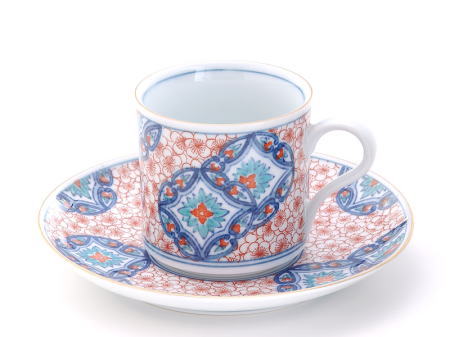
作品名:鍋島桜コ-ヒ-碗皿
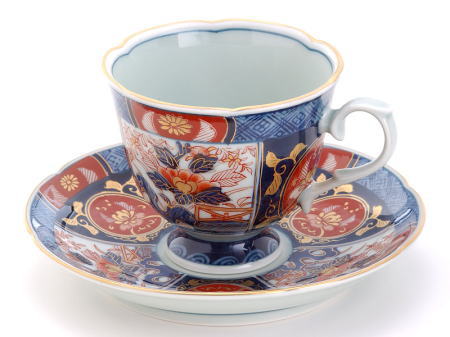
作品名:古伊万里金彩牡丹(赤)コーヒー碗皿
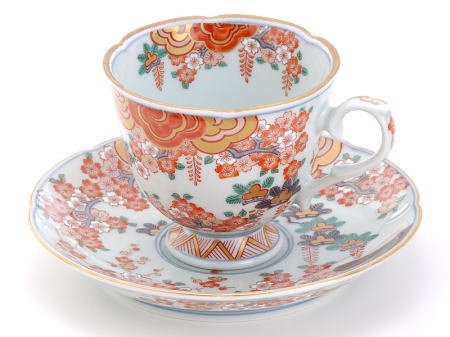
作品名:献上手古伊万里継高台コ-ヒ-碗皿
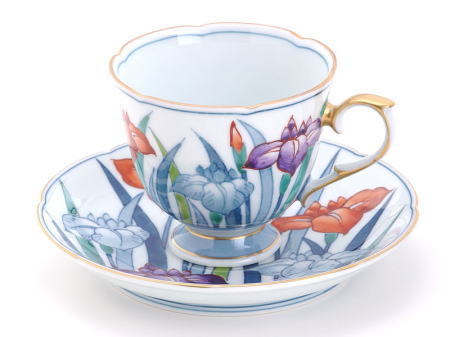
作品名:錦アヤメ継高台コ-ヒ-碗皿
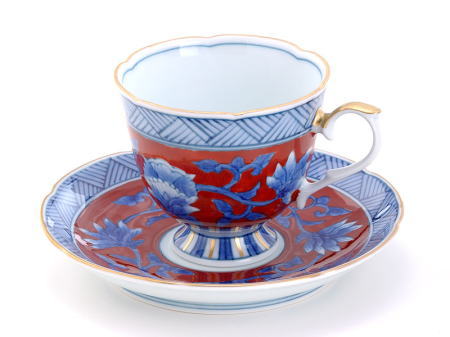
作品名:錦唐草(赤)継高台コ-ヒ-碗皿
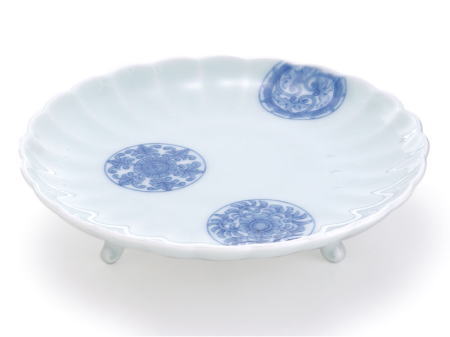
作品名:染付丸紋三ッ足五寸皿
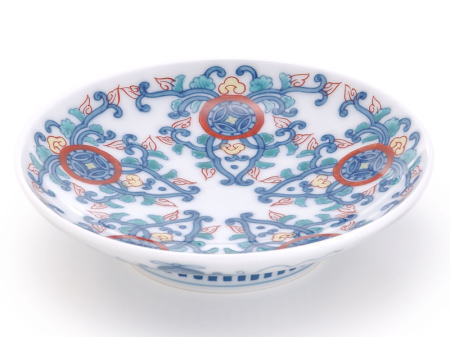
作品名:色絵唐草4寸高台皿
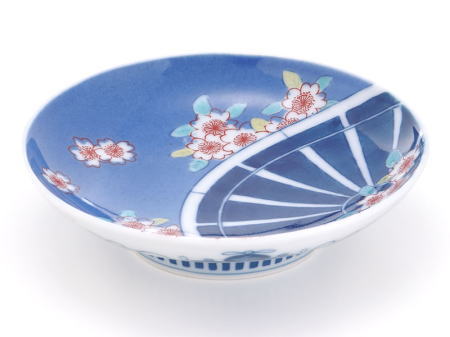
作品名:御所車4寸高台皿
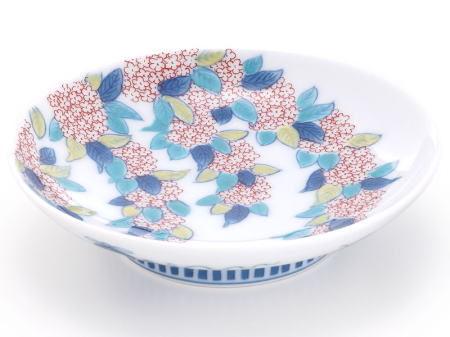
作品名:小手まり4寸高台皿
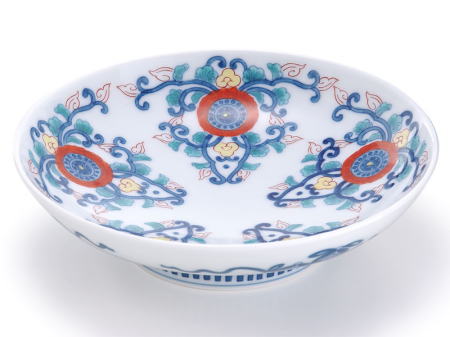
作品名:色絵唐草五寸高台皿
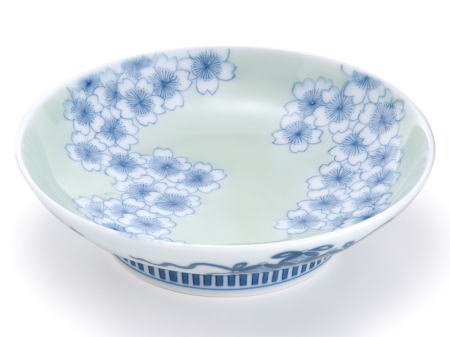
作品名:鍋島青磁桜花紋五寸高台皿
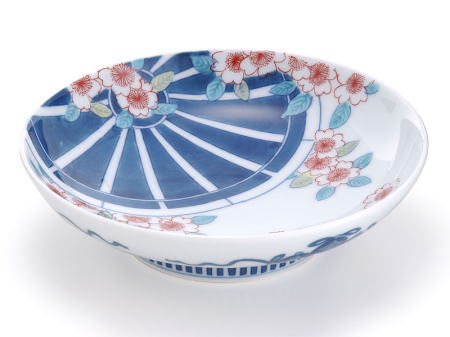
作品名:御所車五寸高台皿
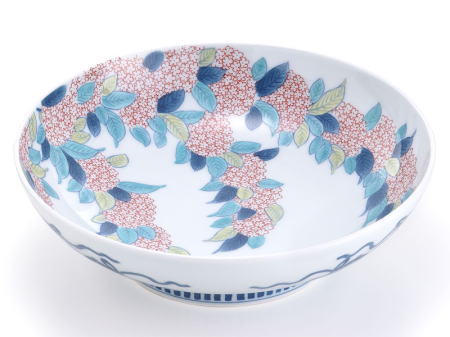
作品名:小手まり七寸高台皿
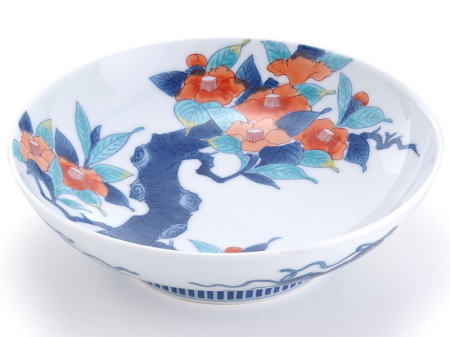
作品名:椿七寸高台皿
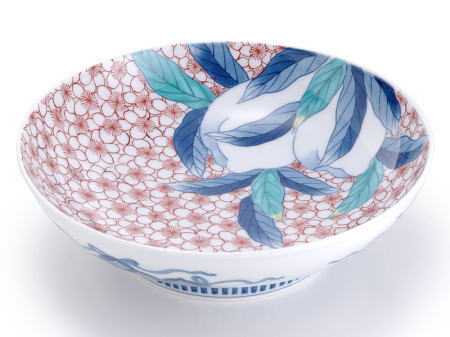
作品名:鍋島桃花果実七寸高台皿
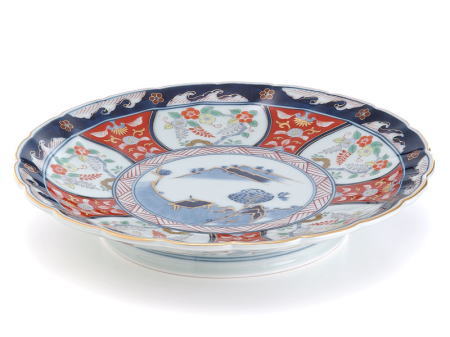
作品名:古伊万里籐花捻菊高台ハ寸皿
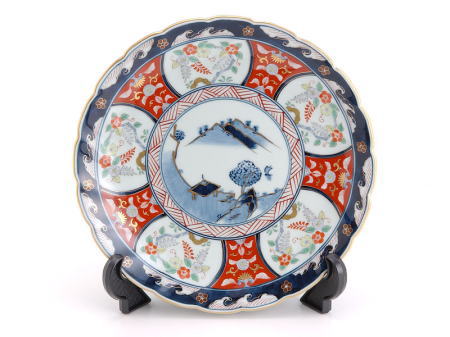
作品名:古伊万里籐花捻菊高台ハ寸皿
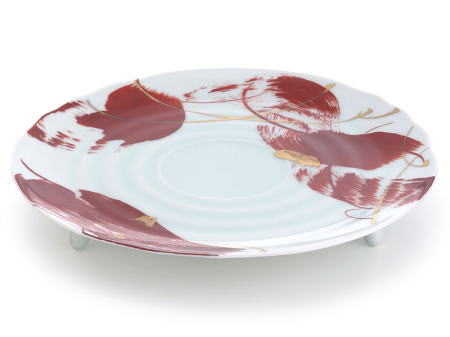
作品名:上絵刷毛目三ヅ足七寸皿
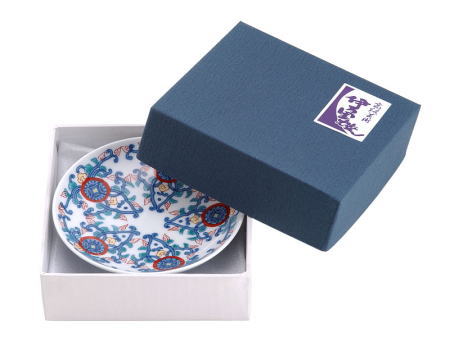
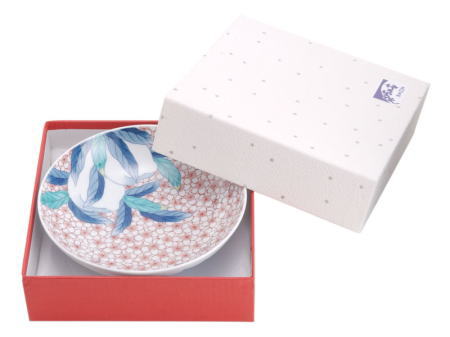
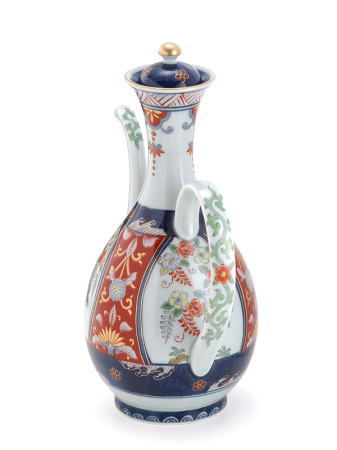
作品名:古伊万里籐花水差し
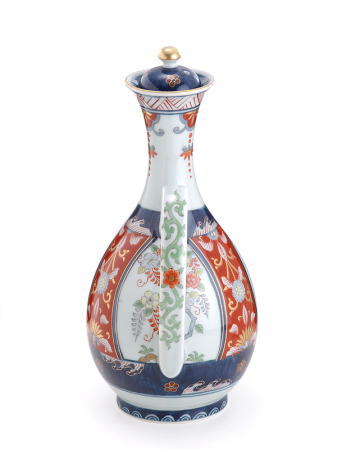
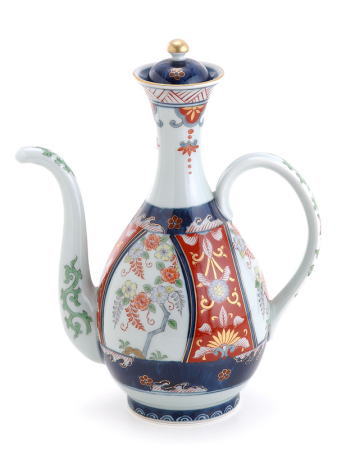
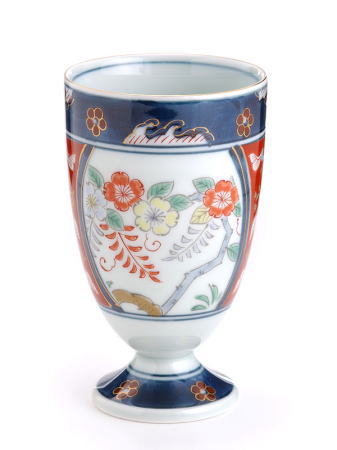
作品名:古伊万里籐花ワイングラス
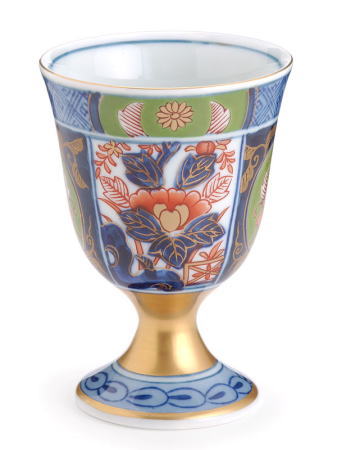
作品名:古伊万里金彩牡丹(グリーン)ワイングフス小
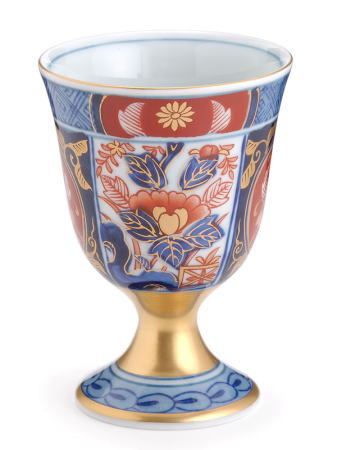
作品名:古伊万星金彩牡丹(赤)ワイングフス小
■The situation of the porcelain in the world and
Imariyaki ~ As the center on Europe~
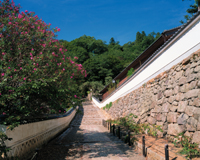 It is in the 13th century that Chinese porcelain appeared for
the first time in Europe. It is told that Marco Polo in
Venezia brought them. Afterwards, the Orient trade
thrived by the great navigation era started in the
15th century, and at the beginning of the 17th century,
the Dutch Ease India company imported a lot of porcelain
as the return freight when they shipped the articles from
Europe to China.
Above all, the porcelain called "Blue and White" and loved
by people was the sometsuke of China Keitokuchin.
At that time, they were evaluated most highly.
However, around the middle of the 17th century,
the Dutch East India Company could not help abandoning the trade with China because the political situation of China were confused.
It is in the 13th century that Chinese porcelain appeared for
the first time in Europe. It is told that Marco Polo in
Venezia brought them. Afterwards, the Orient trade
thrived by the great navigation era started in the
15th century, and at the beginning of the 17th century,
the Dutch Ease India company imported a lot of porcelain
as the return freight when they shipped the articles from
Europe to China.
Above all, the porcelain called "Blue and White" and loved
by people was the sometsuke of China Keitokuchin.
At that time, they were evaluated most highly.
However, around the middle of the 17th century,
the Dutch East India Company could not help abandoning the trade with China because the political situation of China were confused.
■Keitokuchin to Imari, and then to Europe
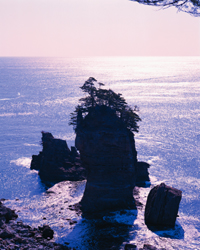 At that time, it was the Ko-Imari to be paid attention as taking
the place of China Keitokuchin.
The Arita porcelain were brought in Europe as Ko-Imari
from the Imari port by Dutch East India company. Then,
therewere the pottery in Europe but there was no
technology for making the porcelain yet. The white and
strong porcelain was the object of envy encompassed
by a mystery veil and the treasures of the unknown world
because the manufacturing process was secret. They were
much more graceful and delicate and translucent than the
pottery. For the people in Europe, the Chinese porcelain
and the Ko-Imari had the same value as money
and valuables, and were the symbol of the wealth and
the power. The royal family and the people of the well-off
classes put buying agent of the pottery specialty in
Amsterdam that was the center of Orient trade and
where the Dutch ships entered port and tried to get ahead
of others in buying them. They provided "a room for
porcelain"and distributed them from the floor to the
ceiling so as to fill up the wall, and made the exhibition shelf
called "Po Sen Cabinet" and proudly decorated the articles
which they obtained. They showed off their own power and their
financial ability by being exposing them to public notice ungrudgingly.
The fashion extended in various parts of Europe, and the porcelain was
collected in the palace in every country one after another. Many of these
are the origin of Ko-Imari collections that are displayed in the art museum
and the museum in every country now. Friedrich Augustus I who was
especially enthusiastic collector of Ko-Imari collected Ko-Imari collection
more than 1,000 pieces from the 17th century to the 18th century.
They are world-wide fame, and exhibited and kept in the Touji museum
in Dresden(Germany).The amount that the East India Company imported
from China is about 3 million pieces from 1604 to 1657. It is recorded in
the diary of the chief of the Dejima business firm that the Imariyaki among
those was 1.9 million pieces for 31 years from 1652 to 1683. This is the
amount of only Netherlands, when this added to the amount of other
East India Company, the amount of pottery were carried to Europe proved
to be enormous.
At that time, it was the Ko-Imari to be paid attention as taking
the place of China Keitokuchin.
The Arita porcelain were brought in Europe as Ko-Imari
from the Imari port by Dutch East India company. Then,
therewere the pottery in Europe but there was no
technology for making the porcelain yet. The white and
strong porcelain was the object of envy encompassed
by a mystery veil and the treasures of the unknown world
because the manufacturing process was secret. They were
much more graceful and delicate and translucent than the
pottery. For the people in Europe, the Chinese porcelain
and the Ko-Imari had the same value as money
and valuables, and were the symbol of the wealth and
the power. The royal family and the people of the well-off
classes put buying agent of the pottery specialty in
Amsterdam that was the center of Orient trade and
where the Dutch ships entered port and tried to get ahead
of others in buying them. They provided "a room for
porcelain"and distributed them from the floor to the
ceiling so as to fill up the wall, and made the exhibition shelf
called "Po Sen Cabinet" and proudly decorated the articles
which they obtained. They showed off their own power and their
financial ability by being exposing them to public notice ungrudgingly.
The fashion extended in various parts of Europe, and the porcelain was
collected in the palace in every country one after another. Many of these
are the origin of Ko-Imari collections that are displayed in the art museum
and the museum in every country now. Friedrich Augustus I who was
especially enthusiastic collector of Ko-Imari collected Ko-Imari collection
more than 1,000 pieces from the 17th century to the 18th century.
They are world-wide fame, and exhibited and kept in the Touji museum
in Dresden(Germany).The amount that the East India Company imported
from China is about 3 million pieces from 1604 to 1657. It is recorded in
the diary of the chief of the Dejima business firm that the Imariyaki among
those was 1.9 million pieces for 31 years from 1652 to 1683. This is the
amount of only Netherlands, when this added to the amount of other
East India Company, the amount of pottery were carried to Europe proved
to be enormous.
Thus, the Ko-Imari are still known the name as the first international brand
produced in Japan. Moreover, the porcelain manufacturing in Europe
imitated the Kakiemon style and the Ko-Imari style and especially had
much influence on Meissen in Germany and Shanti in France.
■The beginning of Meissen in Germany
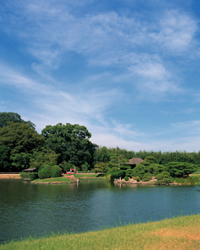 For the royalty and the nobility in Europe from the 17th century to the 18th century, the Japanese and Chinese porcelain had the same value as gold and silver. And, the rulers of those days in Europe like the Hapsblc family, the Bourbon family and the Hannover family etc. were not satisfied with only the collections. And they brought the master of the potter and the painting and had them fired the porcelain in their territories. Friedrich AugustusⅠwas called "Augustus the Strong" and had the political ambition to usurp the throne of other country. At that time, he was the Elector of Saxony and the King of Poland (as AugustusⅡ 1670~1733). In this era, the absolutism monarch strove for supremacy. It was "Beauty" that Augustus the Strong devoted his energies most. First, he embellished Dresden, a capital of Saxony, and it was called "Pearl of Elbe" and " the most beautiful baroque city in Germany". Besides, he brought the painting, the jewelry, the porcelain and all works of art to this capital and opened to the citizens. He built up the cultural administrative city Dresden that was the greatest city in Europe and showed off his own name in and out.
For the royalty and the nobility in Europe from the 17th century to the 18th century, the Japanese and Chinese porcelain had the same value as gold and silver. And, the rulers of those days in Europe like the Hapsblc family, the Bourbon family and the Hannover family etc. were not satisfied with only the collections. And they brought the master of the potter and the painting and had them fired the porcelain in their territories. Friedrich AugustusⅠwas called "Augustus the Strong" and had the political ambition to usurp the throne of other country. At that time, he was the Elector of Saxony and the King of Poland (as AugustusⅡ 1670~1733). In this era, the absolutism monarch strove for supremacy. It was "Beauty" that Augustus the Strong devoted his energies most. First, he embellished Dresden, a capital of Saxony, and it was called "Pearl of Elbe" and " the most beautiful baroque city in Germany". Besides, he brought the painting, the jewelry, the porcelain and all works of art to this capital and opened to the citizens. He built up the cultural administrative city Dresden that was the greatest city in Europe and showed off his own name in and out.
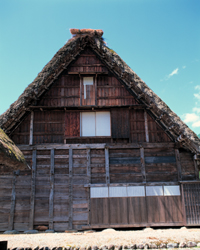 It is the Dresden National Gallery to succeed to this gorgeous collection up to now. It is composed of 12 sections such as "Classics painting pavilion" in which the masterpieces of Raphael and Rembrandt are exhibited, the treasure pavilion "Green dome" which the unparalleled jewelry in this world are displayed throughout, "Porcelain collection room" which are collected 20,000 pieces of the porcelain from all over the world. It is "Miracle of Dresden" that the marvelous collection are protected by the successive monarchs after his death and exist without being scattered and lost, passing through the evils of war of World WarⅡ.
It is the Dresden National Gallery to succeed to this gorgeous collection up to now. It is composed of 12 sections such as "Classics painting pavilion" in which the masterpieces of Raphael and Rembrandt are exhibited, the treasure pavilion "Green dome" which the unparalleled jewelry in this world are displayed throughout, "Porcelain collection room" which are collected 20,000 pieces of the porcelain from all over the world. It is "Miracle of Dresden" that the marvelous collection are protected by the successive monarchs after his death and exist without being scattered and lost, passing through the evils of war of World WarⅡ.
Friedrich AugustusⅠwas especially fond of the Japanese porcelain and pottery and had the collection of around 35,000 articles. Besides he had the plan of the palace only for Imariyaki and determined to produce the same pottery as the Oriental porcelain by himself. And it is the Meissen kiln to be made in Meissen northwestward of Dresden in Germany. In 1694, the King confined alchemist Johann Friedrich Boettger of 19 years old that came to Dresden and compelled him to research into the porcelain. After that, Boettger worked on the researches into that with Walter von Tshirnhaus who was a scientist and a mathematician. Before long, they made the stoneware like Shudoro and in 1708, finally succeeded in discovering the white hard porcelain. However, this success caused the tragedy. The method of the porcelain manufacturing was the top-secret because that was the most advanced technology and made the great profit at that time. He feared that the secret leaked out and confined Boettger. Tshirnhaus fell ill, and Boettger indulged in sake because of the mental suffering under detention and died at 39 years old because of a burn.The glory of the Meissen known with the mark of "Crossed blue swards" was succeeded by the base of such a history, and Germany became the porcelain kingdom of the first class in the world.
 The characteristic of the Meissen porcelain is to use the clay that can be fired at the higher 1400 degree or more than the Japanese porcelain. They are somewhat thick so as not to be broken at the high temperature, and the Yu hardened and they are not so suitable for the uwae. Also, the one of the great characteristic of Meissen porcelain is to have translucency like shining by firing the pure white clay called Kaolin which Boettger had much difficulty in finding. They contains 65% of kaolin and are the best porcelain quality in the world. Also, they contains a mixture of glass matter and mineral that is necessary for the porcelain. And the higher the content rate of them is, the more delicate and the more hard porcelain is manufactured. However, there is a limit to the mineral vein and the production is felt uneasy. It is assumed that this is the one of the reasons that Meissen is the expensive.The modern Meissen porcelain becomes the massive finish because of the material rather than the national character. Because the natural clay is not used as it is like Japan, the purity is high and the bright shade of color can be made. Moreover, because they took the Imariyaki(Aritayaki) as the model, they have many design of the Orient style now.
The characteristic of the Meissen porcelain is to use the clay that can be fired at the higher 1400 degree or more than the Japanese porcelain. They are somewhat thick so as not to be broken at the high temperature, and the Yu hardened and they are not so suitable for the uwae. Also, the one of the great characteristic of Meissen porcelain is to have translucency like shining by firing the pure white clay called Kaolin which Boettger had much difficulty in finding. They contains 65% of kaolin and are the best porcelain quality in the world. Also, they contains a mixture of glass matter and mineral that is necessary for the porcelain. And the higher the content rate of them is, the more delicate and the more hard porcelain is manufactured. However, there is a limit to the mineral vein and the production is felt uneasy. It is assumed that this is the one of the reasons that Meissen is the expensive.The modern Meissen porcelain becomes the massive finish because of the material rather than the national character. Because the natural clay is not used as it is like Japan, the purity is high and the bright shade of color can be made. Moreover, because they took the Imariyaki(Aritayaki) as the model, they have many design of the Orient style now.
Go to the top